August in the Grand Canyon
Learn about visiting Grand Canyon National Park in August
Updated: 10/27/22
August in Grand Canyon National Park is the height of the monsoon season, with thunderstorms and dramatic skies forming incredible backdrops for evening hikes and walks or dinners at Grand Canyon Lodge. August is still quite busy with peak summer visitation not tapering off until later in the month. The North Rim is open and August is a wonderful time to experience the lesser-visited side of the Canyon.
Benefits of Visiting in August
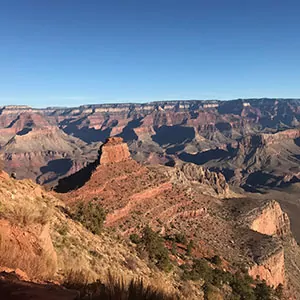 A huge benefit of visiting the Grand Canyon in August, like July, is the wonderful temperatures for camping on the South and North Rim. While the park is famed for its heat (and rightly so), the rims are mountainous environments and temperatures remain pleasant in the summer. The North Rim is closed to private vehicles for almost six months of the year. making this time of year a luxury. This much less touristy side of the park is more remote and has more wildlife than the South Rim. While the South Rim is famous and has more iconic sites, many visitors claim the North Rim as their favorite. Perhaps due to the solitude, as it receives less than 15% of all yearly visitors. The North Rim Campground is lovely in August, allowing visitors to camp in pine and aspen forests at only a short walk to the edge of the Canyon. South Rim camping is also excellent, and there are multiple campground options there. The pleasant, mountain summer weather makes each rim excellent for sightseeing, photography, biking, or other tours. See more about Grand Canyon camping or all-inclusive hiking and camping tours.
A huge benefit of visiting the Grand Canyon in August, like July, is the wonderful temperatures for camping on the South and North Rim. While the park is famed for its heat (and rightly so), the rims are mountainous environments and temperatures remain pleasant in the summer. The North Rim is closed to private vehicles for almost six months of the year. making this time of year a luxury. This much less touristy side of the park is more remote and has more wildlife than the South Rim. While the South Rim is famous and has more iconic sites, many visitors claim the North Rim as their favorite. Perhaps due to the solitude, as it receives less than 15% of all yearly visitors. The North Rim Campground is lovely in August, allowing visitors to camp in pine and aspen forests at only a short walk to the edge of the Canyon. South Rim camping is also excellent, and there are multiple campground options there. The pleasant, mountain summer weather makes each rim excellent for sightseeing, photography, biking, or other tours. See more about Grand Canyon camping or all-inclusive hiking and camping tours.
Another addition to visiting during August is the perfect conditions for white water rafting. Temps in the canyon are almost always over 100°F making the summer a fantastic opportunity to luxuriate in the Colorado River. Rafting trips vary in length from a single day to 18 days, with options abound, check with a local guiding company for further details.
August is the height of Arizona’s monsoon season, meaning that many afternoons will have thunderstorms and lightning. While these thundershowers can be inconvenient to those who want to stroll along the rims, the dramatic skies, sheets of rain, and flashes of lightning make for exceptional photography. Read up in our weather section about how to stay safe in a thunderstorm, because if at a safe distance, the storms could be the highlight of a trip!
One drawback to visiting in August is the crowds however, the heat deeper into the canyon makes most visitors stay up on the rim and thus reservations at Phantom Ranch are much easier to come by. This much sought-after accommodation on the canyon floor is booked solid months in advance, but in the heat of summer and the cold of winter, you might be able to find reservations on shorter notice. Tour options in August are more robust than in other months due to the lower number of visitors. Many of these trips are a great way to escape the crowds and get further into the wilderness while staying safe with an expert guide.
Drawbacks of Visiting in August
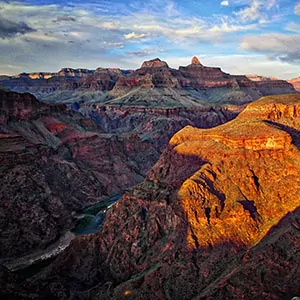 The biggest downside of visiting the Grand Canyon in August is the sweltering temperatures inside the Canyon. The desert environment within the canyon makes for triple-digit temperatures, frequently rising above 105°F, with the highest ever recorded being 120°F. This makes hiking, backpacking, and other activities at the bottom of the canyon somewhat uncomfortable and possibly dangerous. Most hikes should start before sunup and finish before 11 AM. If venturing on a longer hike, prepare to sit in the shade for a few hours in the middle of the day to avoid the heat. Heat exhaustion and heat stroke are real threats and severely limit your ability to explore the canyon to its greatest extent. The heat in August can be mitigated by the frequent afternoon monsoon showers. But the showers come with their own dangers of lightning, rockfalls, and flash floods. Flash floods can be very dangerous to backpackers who can have their entire camps washed away or have an exit route blocked if they’re not careful. They are also a danger to rafters as the floods can make rapids more treacherous, block side hikes, and possibly wash away camps. Despite the dangers, these floods are genuinely amazing to watch from a safe distance. It could be a highlight of your trip to witness an amazing flood rushing through to create a smaller version of the Grand Canyon.
The biggest downside of visiting the Grand Canyon in August is the sweltering temperatures inside the Canyon. The desert environment within the canyon makes for triple-digit temperatures, frequently rising above 105°F, with the highest ever recorded being 120°F. This makes hiking, backpacking, and other activities at the bottom of the canyon somewhat uncomfortable and possibly dangerous. Most hikes should start before sunup and finish before 11 AM. If venturing on a longer hike, prepare to sit in the shade for a few hours in the middle of the day to avoid the heat. Heat exhaustion and heat stroke are real threats and severely limit your ability to explore the canyon to its greatest extent. The heat in August can be mitigated by the frequent afternoon monsoon showers. But the showers come with their own dangers of lightning, rockfalls, and flash floods. Flash floods can be very dangerous to backpackers who can have their entire camps washed away or have an exit route blocked if they’re not careful. They are also a danger to rafters as the floods can make rapids more treacherous, block side hikes, and possibly wash away camps. Despite the dangers, these floods are genuinely amazing to watch from a safe distance. It could be a highlight of your trip to witness an amazing flood rushing through to create a smaller version of the Grand Canyon.
Another major downside of August is the higher concentration of crowds, especially on the rims. On the South Rim, one can anticipate long lines for NPS shuttles, full hotels, and peak summer hotel rates. It should be noted, that by late August the park is quieter, as schools start back up and families are no longer visiting. The North Rim is typically a blessed relief from the crowds, as many visitors choose to stay on the South Rim. Higher groups also mean that accommodation rates go up and accommodation availability goes down. While you might be able to get away with a last-minute trip at the end of August, most of the month will be booked many months in advance, and you will struggle to find last-minute reservations within the park. To maximize your time, reduce worry about reservations and transportation, and safely hike the Canyon in the summer, consider joining a Grand Canyon hiking tour. Expert tour guides will know all the secret spots to avoid the crowds and will ensure you’re not missing any essential safety information so that you can relax and enjoy your trip.
Things to Do in August
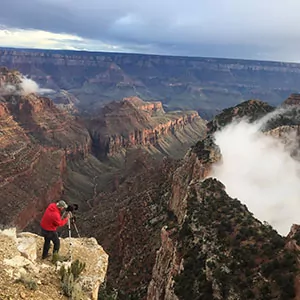 There are nearly endless things to do in the Grand Canyon in August as the possibilities in the canyon and on the rims are so different. If you can plan far enough ahead, a Colorado River rafting trip is a fun activity for August. Being deluged by the chilly water of the river while crashing through rapids is very refreshing in the summer. 6-21 day Colorado River rafting tours and one-day rafting tours are available.
There are nearly endless things to do in the Grand Canyon in August as the possibilities in the canyon and on the rims are so different. If you can plan far enough ahead, a Colorado River rafting trip is a fun activity for August. Being deluged by the chilly water of the river while crashing through rapids is very refreshing in the summer. 6-21 day Colorado River rafting tours and one-day rafting tours are available.
Tent camping on the South Rim and the North Rim is fantastic in August, as visitors enjoy pleasant summer temperatures, cool summer nights, and fantastic vista views. Hiking part-way into the Canyon is an option in August, but it’s critical to begin your hike before sunup and be out of the Canyon by mid-morning. The heat increases with every step you take down into the canyon and hiking back out can take twice as long as hiking down. Many inexperienced hikers are lured into this activity by the initial downhill hiking and cooler temperatures at the rim. Do not make the mistake of beginning a hike mid-morning. If you ever find yourself at the bottom of the canyon at midday about to turn around, wait. It is worth waiting a few extra hours at Phantom Ranch or Bright Angel Creek to prevent heat-borne conditions. Most visitors that needed medical attention due to heat exhaustion or heat stroke were hiking between 10 AM and 4 PM.
Backpacking can be a great activity in August, but if you don’t have desert hiking experience, especially in the summer, we recommend joining a backpacking tour to more safely negotiate the heat of the Canyon, especially halfway down and lower. Sticking to the Corridor (South Kaibab, North Kaibab, and Bright Angel Trails) is highly recommended in August. Bright Angel Trail is the safest in summer as there is shade and water every 1.5 miles. Heat exhaustion, heat stroke, water poisoning, flash floods, lightning strikes, wildlife danger, and many other risks come with being in the backcountry in the Grand Canyon, so you’ll want to make sure you know what you were doing or are with someone who does.
If your passion is photography, we strongly advise checking weather forecasts, and if monsoons are coming, posting yourself and your camera at one of the more dramatic viewpoints (Yaki Point, Hopi Point, or Powell Point) to get dramatic photos of thunderstorms descending on the Canyon. Please note to be careful of lightning as lightning injuries and deaths at South Rim viewpoints have occurred. Stay at least five miles away from thunderstorms (five seconds between a lightning flash and a thunderclap equals 1 mile) to ensure your safety. If the storm begins to move closer, move away from the rim, avoid wide-open spaces and tall trees, seek shelter, and do not touch any metal either on railings or vehicles.
If you need some indoor activities to wait out a storm or a heat wave, the Yavapai Geology Museum, which has fantastic exhibits on fossils and geology in the park, or the Kolb Studio and photo gallery are great options. Both visitor centers in the park have great exhibits and a 22-minute park film that is informative and will entertain the kids. If you have a whole extra day to spend, consider a trip on the Grand Canyon Railway from the nearby town of Williams that will take you back in time to the land of rail travel and outlaws. Native American and early settler history is also available to see in the park at the Tusayan Museum and Ruin, Eagle Point Native American village on the west rim, or the Desert View Watchtower to the east. There are nearly endless possibilities for activities in the park, so gear up for the adventure of your choice.
THings to see in August
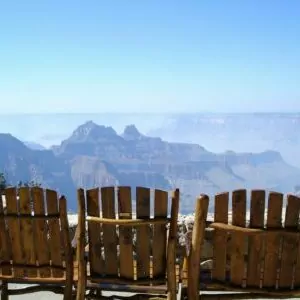 There are nearly as many things to see in August as there are to do, which is a lot! Sightseeing is one of the most popular activities because of the pleasant temperatures on the rims. So if sightseeing is the main item on your to-do list, rest assured you won’t be bored. We’ve compiled a list of some of the must-see sights in August, but make sure to do your own research on what piques your interest in the park, as this list is by no means exhaustive.
There are nearly as many things to see in August as there are to do, which is a lot! Sightseeing is one of the most popular activities because of the pleasant temperatures on the rims. So if sightseeing is the main item on your to-do list, rest assured you won’t be bored. We’ve compiled a list of some of the must-see sights in August, but make sure to do your own research on what piques your interest in the park, as this list is by no means exhaustive.
Hopi Point: One of the best viewpoints for sunrise or sunset in the entire park, this overlook is known for its panoramic vistas. Located along Hermit’s Rest scenic drive, you will not be able to drive your private vehicle down this road this time of year, but you can take the shuttle, walk or ride a bike. If you have bikes available, it can be a lovely ride at sunrise or sunset when the crowds are lessened and the temperatures are cool.
North Rim: For much of the year, the North Rim is only accessible via hiking from the South Rim. But in the summer you can drive your private vehicle to this remote and wild section of the park. Stroll along any of the rim trails, hike down into the canyon, or look for wildlife such as bison and elk that are much more plentiful here than on the south rim.
Desert View Watchtower: This watchtower located near the east entrance of the park is many visitors’ first chance to see the canyon and peekaboo glimpses of the Colorado. Designed by the famous park architect Mary Colter, the tower seems to be rising out of the very canyon walls itself. If you’re coming in from the east, take time to stop at this tower and climb up to the top for your first spectacular views of the park’s main feature.
Thunderstorms: July and August are Arizona’s monsoon season and thunderstorms are not uncommon in the afternoons. While they can be dangerous and need to be treated with respect, these storms are spectacular to see descending over the canyon. Flashes of lightning, sheets of rain, and dark dramatic clouds make for excellent photography and simply stunning views to just watch.
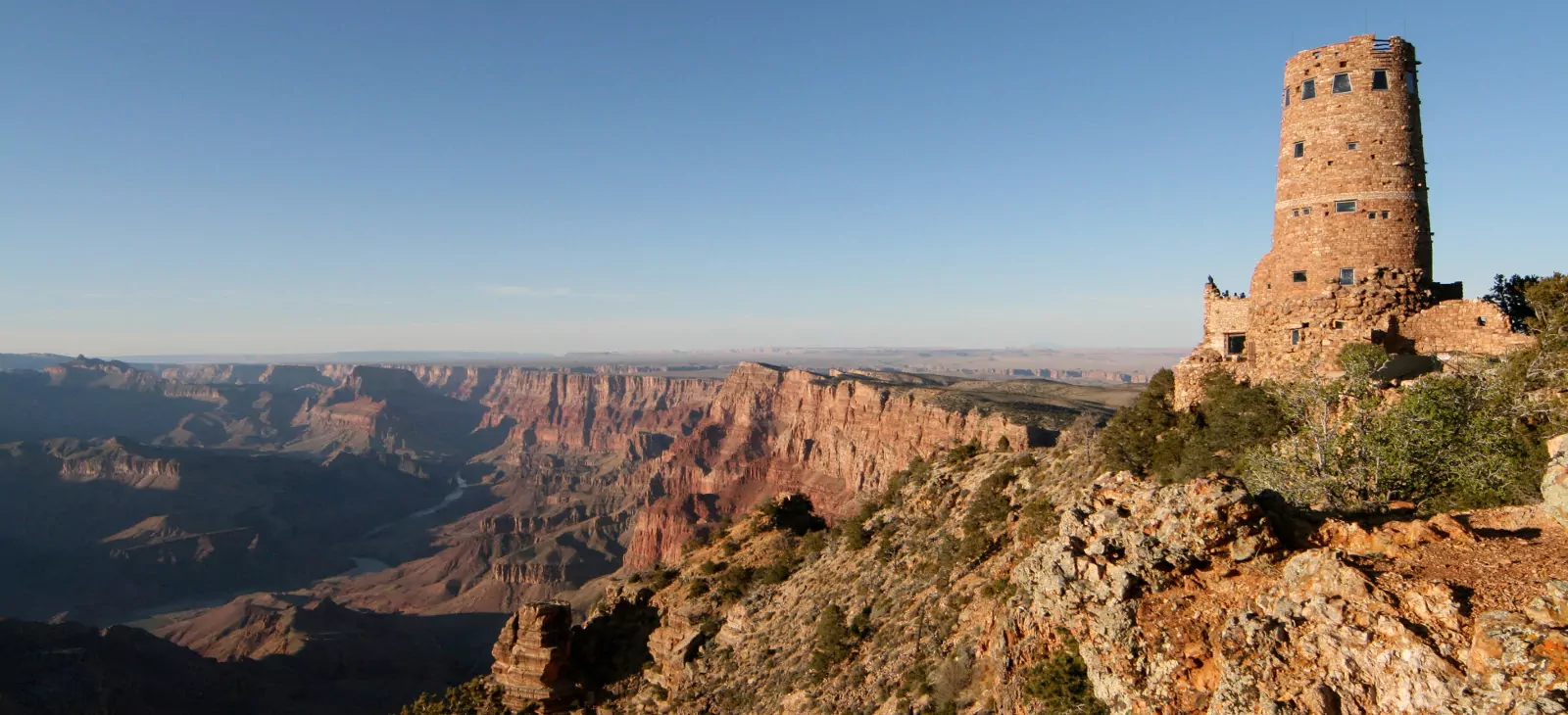
Hiking in August
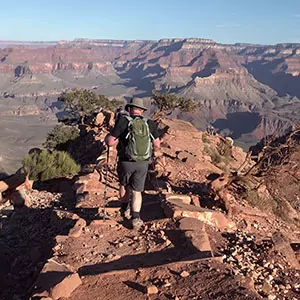 Hiking can be great in August, but there are some hazards that hikers need to be aware of before they set out on the trail. The most important one is the summer heat inside the Canyon. Many inexperienced visitors are lured into hiking by the initial downhill trek and the cooler temperatures on the rims. Do not be fooled; the heat intensifies with every step farther into the canyon and it can take twice as long to hike back up as it took to hike down. If going on a day hike, it’s strongly recommended to begin very early (hiking before sunup) and be back to the rim by mid-morning. Stay on Corridor Trails: South Kaibab, North Kaibab, and Bright Angel. Bright Angel Trail is the most secure summer trail in the Canyon because it has shade and water every mile and a half. If you’re hiking from one rim to the other in one day, begin your hike around 2 or 3 am, rest in the shade and creek water neat Phantom Ranch from 10 am to 4 pm (the hottest part of the day), and conclude your hike in the late afternoon/evening. The national park service does not recommend hiking rim to rim in one day any season, so it is much safer to do a backpacking trip and stay the night at the bottom of the canyon if you want to do this hike. See NPS’s Summer Hike Smart Tips for more information.
Hiking can be great in August, but there are some hazards that hikers need to be aware of before they set out on the trail. The most important one is the summer heat inside the Canyon. Many inexperienced visitors are lured into hiking by the initial downhill trek and the cooler temperatures on the rims. Do not be fooled; the heat intensifies with every step farther into the canyon and it can take twice as long to hike back up as it took to hike down. If going on a day hike, it’s strongly recommended to begin very early (hiking before sunup) and be back to the rim by mid-morning. Stay on Corridor Trails: South Kaibab, North Kaibab, and Bright Angel. Bright Angel Trail is the most secure summer trail in the Canyon because it has shade and water every mile and a half. If you’re hiking from one rim to the other in one day, begin your hike around 2 or 3 am, rest in the shade and creek water neat Phantom Ranch from 10 am to 4 pm (the hottest part of the day), and conclude your hike in the late afternoon/evening. The national park service does not recommend hiking rim to rim in one day any season, so it is much safer to do a backpacking trip and stay the night at the bottom of the canyon if you want to do this hike. See NPS’s Summer Hike Smart Tips for more information.
The best way to avoid heat-caused conditions in the canyon is to not hike when it’s hot. Start your hike before sunrise and finish it before 10 or 11 AM. If you find yourself in a situation where you are beginning to climb out of the canyon in the heat of the day, wait. It is worth waiting a few hours for the heat to subside instead of risking illness to climb out. It’s also a good idea to keep a flashlight in your bag so that you have the option of hiking after dark if you need to.
It is important to know the difference between heat exhaustion and heat stroke as the latter is a medical emergency and needs immediate treatment. Park rangers treat many cases of heat exhaustion every day in the summer and the park usually has a few cases of heat stroke as well. Dehydration can speed up both of these conditions as excessive sweating and not drinking enough water will put a greater strain on your body to cool itself down. If you find yourself near a river or creek, feel free to plunge in completely as this will keep you cool and probably make your hike more pleasant. Make sure to use caution in the Colorado River, as strong currents can pull swimmers under.
Water poisoning or water intoxication is also a risk in the canyon, but it’s less well-known compared to other conditions caused by heat. Water poisoning is caused by visitors being overzealous with drinking water and not eating enough while on the trail. This can cause a sodium imbalance in your bloodstream making your cells swell with water. If this happens in your brain, it can be life-threatening, so make sure you’re carrying salty snacks and eating as well as drinking while you’re on the trail. For those wanting to hike in the summer, it is highly advisable to go with a guiding company, even on just a day hike to make sure you have a certified, expert guide who is accustomed to hiking in the region and will know how to react in an emergency situation.
backpacking in august
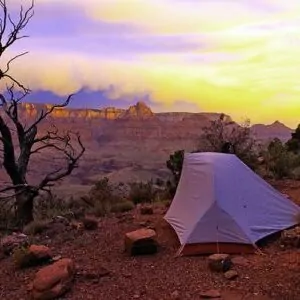 Backpacking is possible in August and it comes with additional risks visitors need to be aware of. If you’re interested in a backpacking trip, consider joining a guided trip to maximize your safety and comfort. This will allow you to enjoy the canyon in that special backpacking way while still remaining safe by being with an expert guide who has done the treks before and knows how to react in a dangerous situation, should one arise.
Backpacking is possible in August and it comes with additional risks visitors need to be aware of. If you’re interested in a backpacking trip, consider joining a guided trip to maximize your safety and comfort. This will allow you to enjoy the canyon in that special backpacking way while still remaining safe by being with an expert guide who has done the treks before and knows how to react in a dangerous situation, should one arise.
Hiking with a full backpack will make the heat more of a danger, as you are more likely to lose water through sweat. You will need to carry more water and more food than you normally would on a backpacking trip elsewhere or on a day hike of the same length. Besides the heat, August poses dangers of flash floods, rock falls, and lightning strikes as the monsoon season is at its peak with frequent afternoon thundershowers. All these dangers can be life-threatening and those preparing to go backpacking in summer need to know what to do in situations with these factors. Any trip outside a rim-to-rim hike on the Corridor trails should not be attempted on your own unless you’re an experienced desert hiker. If you want to do a longer trip, consider booking a trip with a guiding company that will take care of much of your gear, itinerary, and all the safety logistics. Summer in Grand Canyon is not to be laughed at and comes with some serious dangers, but it can be rewarding if you are willing to put in the work to make sure your trip is safe and enjoyable.
Weather in August
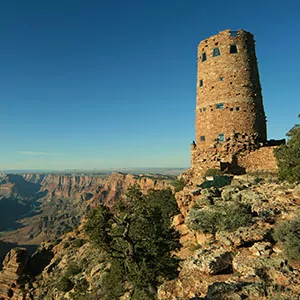 The Grand Canyon is a large park and its main feature, the canyon itself, makes for wildly various weather patterns. As we said before, the park is famed for its heat inside the canyon, but lesser-known is the mountainous Alpine environments on the rims that remain pleasant in summer and receive large amounts of snow in the winter. The average high at the South Rim in August is 82 degrees Fahrenheit, and the average low is 49 degrees Fahrenheit (high of 28 degrees Celsius, low 9 degrees Celsius.) However, these temperatures are much warmer inside the Canyon, sometimes by 10-20 degrees, and feel even warmer in the sun. At Phantom Ranch at the bottom of the Canyon, the average high temperature in August is 103 degrees Fahrenheit, and the low of 74 degrees Fahrenheit (39H/23L degrees Celsius.) August averages six days of rain. Temperatures inside the canyon are very often over 105°F with the highest ever recorded being 120°F. These are mostly ambient air temperatures in the shade; it can feel much hotter in the sun or when you’re exerting yourself.
The Grand Canyon is a large park and its main feature, the canyon itself, makes for wildly various weather patterns. As we said before, the park is famed for its heat inside the canyon, but lesser-known is the mountainous Alpine environments on the rims that remain pleasant in summer and receive large amounts of snow in the winter. The average high at the South Rim in August is 82 degrees Fahrenheit, and the average low is 49 degrees Fahrenheit (high of 28 degrees Celsius, low 9 degrees Celsius.) However, these temperatures are much warmer inside the Canyon, sometimes by 10-20 degrees, and feel even warmer in the sun. At Phantom Ranch at the bottom of the Canyon, the average high temperature in August is 103 degrees Fahrenheit, and the low of 74 degrees Fahrenheit (39H/23L degrees Celsius.) August averages six days of rain. Temperatures inside the canyon are very often over 105°F with the highest ever recorded being 120°F. These are mostly ambient air temperatures in the shade; it can feel much hotter in the sun or when you’re exerting yourself.
August is the height of Arizona’s monsoon season, so visitors should expect thundershowers to suddenly roll in in the afternoon quite frequently. While these thundershowers are amazing to watch from a safe distance, they can be dangerous in a variety of ways. Lightning strikes on the rims happen almost every year and especially those who want to do photography you should be aware of this and keep an eye on how far the storm is away from them. Rockfalls can be caused by storm rain and lightning, but undoubtedly the weather caused by the storm that impacts the most people is flash floods. Particularly for backpackers and river rafters, these flash floods can block escape routes and wash away camps, gear, and yourself if you’re not careful. You can read more about these events and the safety of dealing with them on the National Park Service’s safety page.
Despite the rain in August, heat is still the most likely weather to cause you harm. Many inexperienced visitors think that hiking in the canyon will be no problem and are fooled by the cooler temperatures at the rim and the initial downhill hiking. It is important not to be fooled. The heat intensifies with every step you take further into the canyon and can lead to heat exhaustion and heat stroke, the former of which can lead to the latter, and the latter of which can lead to death.
Visitors should also be aware of the high elevation and dry climate of the canyon, especially if you are used to living near sea level or in a humid climate. The elevation will make many visitors out of breath and out of energy sooner than they would at sea level and the dry air can crack skin and cause allergy-like symptoms. If you’re there for more than a few days you should acclimate to the elevation, but it is good practice to factor it in when thinking about your day’s activities. As we talked about in the hiking section, heat exhaustion, heat stroke, and water poisoning are very real risks if you decide to hike into the canyon.
If you are staying on the rims, particularly if you are camping, be aware of the dangers of hypothermia at night and bring layers to keep warm. Always be sure to check the forecast before you set out for the day, especially keep your eye out for afternoon thundershowers. With so many different options, you are sure to find a place in this park where the weather suits what you’d like to do, whether it be bundled up around the campfire at night or getting drenched with freezing river water to cool down in the 100+ degree air.
Wildlife in August
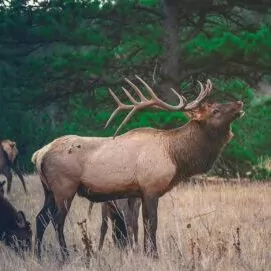 The Grand Canyon is brimming with wildlife and with two distinct habitats, the desert and the mountains, you will have plenty of chances to see them. August brings a special time of year as it is the beginning of the rut, mating season for elk and bison. While bison can only be found on the north rim, elk can be found on both rims and are often seen by visitors. This time of year is amazing for wildlife viewing as bull elk and bison head-butt each other and fight for the right to mate. It is extra important to keep your distance from these animals during this time, as especially males can become aggressive and territorial.
The Grand Canyon is brimming with wildlife and with two distinct habitats, the desert and the mountains, you will have plenty of chances to see them. August brings a special time of year as it is the beginning of the rut, mating season for elk and bison. While bison can only be found on the north rim, elk can be found on both rims and are often seen by visitors. This time of year is amazing for wildlife viewing as bull elk and bison head-butt each other and fight for the right to mate. It is extra important to keep your distance from these animals during this time, as especially males can become aggressive and territorial.
Inside the canyon, many of the park’s reptiles and amphibians will be out and about for the warmer weather so keep your eye out for rattlesnakes, collared lizards, and short-horned lizards. Gilla monsters, one of the only venomous lizards in the United States, also live in the park but are really seen by visitors. If you see one of these characteristically black and orange lizards, keep your distance. While a bite from this reptile is not fatal to humans, it is very painful and will probably land you in the hospital.
If you’re staying at the bottom of the canyon near the Phantom Ranch, keep an eye out at night for a ringtail, often called a ringtail cat. This strictly nocturnal animal is often described as “the cutest animal you’ve ever seen” and can sometimes be seen in the evening around Phantom Ranch scavenging for scraps. Other animals you might see in the park are bighorn sheep, mule deer, ravens, and many species of squirrels. Surprisingly, squirrels cause the most injuries to humans of any animal in the park, usually scratches and bites. Never feed squirrels that you see as this encourages aggressive behavior and can lead to disease through contact with these animals.
One of the most famous wildlife residents of the Grand Canyon is a California condor. The largest bird native to North America with a wingspan that can reach up to 9 1/2 feet, this scavenger was brought back from the brink of extinction through captive breeding programs. They are often confused with vultures but are much larger and have white splotches on the underside of their wings. While still endangered, the park has a small but stable population of these birds, and they can often be seen riding the updrafts of the warm air rising from the canyon. Because of the heat in the summer, many of the animals will be active near dawn, dusk, and night to escape the heat. If you’re interested in finding a particular animal, ask a ranger where the best place to find one would be or what has been recently caught on remote camera traps.
Recommended Wildland trips in August
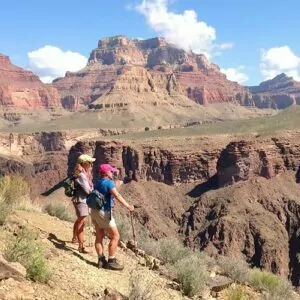 August is a great time to visit the Grand Canyon, but planning out a trip there yourself can be stressful with the large crowds and danger from the severe weather. But you can bypass all that headache by booking a trip with Wildland Trekking. All of our trips are all-inclusive so we will take care of the meals, accommodations, itineraries, local transportation, logistics, and most other things that you can think of. Especially if you want to go backpacking, it is a good idea to go with a guiding company that will provide you with expert guides who have done the trip before and understands how to stay safe. We offer trips in a variety of styles from backpacking and camping tours to inn-based trips and day hikes. Feel free to browse all the trips we offer in the Grand Canyon, but here are a few we especially recommend for August.
August is a great time to visit the Grand Canyon, but planning out a trip there yourself can be stressful with the large crowds and danger from the severe weather. But you can bypass all that headache by booking a trip with Wildland Trekking. All of our trips are all-inclusive so we will take care of the meals, accommodations, itineraries, local transportation, logistics, and most other things that you can think of. Especially if you want to go backpacking, it is a good idea to go with a guiding company that will provide you with expert guides who have done the trip before and understands how to stay safe. We offer trips in a variety of styles from backpacking and camping tours to inn-based trips and day hikes. Feel free to browse all the trips we offer in the Grand Canyon, but here are a few we especially recommend for August.
South Rim Basecamp Tour: This 3-day camping tour is just short enough to do in a long weekend but long enough to give you a true taste of what the Grand Canyon has to offer. Enjoy the cooler rim temperatures and three distinct day hikes before returning to your cozy camping accommodations with access to showers. All-inclusive with meals, local transportation, and an expert guide included, you won’t regret joining this Grand Canyon adventure.
Summer Rim to Rim in the Grand Canyon: This trip is on many backpackers’ bucket lists. Hiking all the way down to the bottom of the canyon and back up is a truly amazing experience as you get to understand both habitats in the park uniquely. Enjoy this hike in the summer despite the heat with an expert guide who will be a great resource and hopefully give you some tips for keeping you cool. If you want to do this hike, but can only visit in the summer, this is the way to go as you will be much more relaxed with a guide who has done it all before.
Zion, Bryce, Grand Canyon Tour: Experience wonders in three different national parks on this fantastic 6-day inn-based tour. With just enough time in each park to get a taste of what it’s like, you’ll be begging to come back to each of them and experience them more fully. All-inclusive with your lodging, meals, local transportation, and expert guide included, without doubt, this tour will be an adventure of a lifetime.
Havasupai Garden and Plateau Point: This classic backpacking trip takes you down the famous Bright Angel Trail and lets you see some of the most amazing vistas in the park. Camp at a centuries-old Native American oasis garden before hiking on to plateau point, well known as one of the most fantastic views of the canyon and the Colorado River. Just three days in the backcountry, this trip won’t be too much for summer and has great shade and a creek also to keep you cool.
Join a Guided Hiking Adventure
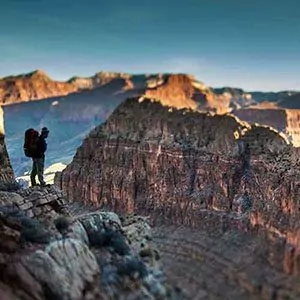 Grand Canyon National Park is home to some of the most unique and spectacular hiking vacations in the world. Wildland Trekking offers trips with stunning views, geologic history, and incredible hiking and backpacking for visitors who want to have an active, adventurous experience.
Grand Canyon National Park is home to some of the most unique and spectacular hiking vacations in the world. Wildland Trekking offers trips with stunning views, geologic history, and incredible hiking and backpacking for visitors who want to have an active, adventurous experience.
Guided Grand Canyon treks include permits, local transportation (excluded on certain tours), meals, gear, risk management systems, and professional guides, allowing guests to make the most of their visit to the Canyon, focus 100% on enjoying their experience, and do it all with an increased level of safety and comfort.
GRAND CANYON ADVENTURE TOURS
- GUIDED BACKPACKING ADVENTURES: these are for people interested in an authentic adventure deep in the Canyon’s wilderness.
- HORSE-ASSISTED TRIP: on this trip to the bottom of the Canyon, guests hike with light day packs and camp near the Colorado River.
- PHANTOM RANCH TOURS: this tour (limited dates) goes to the bottom of the Canyon where we sleep 1 or 2 nights in the Phantom Ranch Lodge 5 minutes from the Colorado River. Showers, A/C, heat…etc.
- ALL-INCLUSIVE HIKING PACKAGES: inn-based and camping-based hiking packages provide all-around hiking experiences of the Grand Canyon.
- DAY HIKE TOURS: maximize your day at Grand Canyon on a fully guided, award-winning hiking tour on one of the Park’s best trails.





